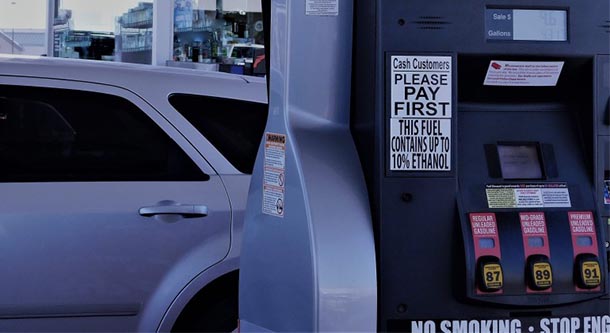
Today’s national gas price average is $1.92. That is nine cents cheaper than last Monday, 48 cents less than a month ago and 81 cents less expensive than a year ago. On the week, pump prices continued to push less expensive with gasoline demand registering at its lowest point since 1993. The latest Energy Information Administration (EIA) weekly report puts demand at 6.7 million b/d – a nearly 30 year low – and it’s likely to push lower as Americans are urged to stay at home at least until the beginning of May.
“This week, market analysts are watching crude oil prices, which started to increase at the end of last week,” said Jeanette Casselano, AAA spokesperson. “However, given the low demand readings, increases in crude aren’t likely to have an impact on gas prices in the near-term.”
In addition to crude oil, market analysts are also watching refinery rates. The U.S. refinery utilization average is down to 82%, a low not seen since September 2017. Given the drop in crude oil and gasoline demand, which is expected to push even lower, refineries are reducing production in hopes this could help to balance the amount of gasoline supply in the country.

Quick Stats
- The nation’s top 10 largest weekly decreases are: Wisconsin (-16 cents), Vermont (-15 cents), Idaho (-14 cents), Alaska (-12 cents), Iowa (-12 cents), Kentucky (-11 cents), Arkansas (-10 cents), Ohio (-10 cents), Michigan (-10 cents) and Arizona (-10 cents).
- The nation’s top 10 least expensive markets are: Wisconsin ($1.43), Oklahoma ($1.47), Ohio ($1.55), Kentucky ($1.58), Michigan ($1.61), Indiana ($1.62), Mississippi ($1.63), Arkansas ($1.64), Texas ($1.65) and Iowa ($1.66).

Great Lakes and Central States
Five Great Lakes and Central States are seeing the largest year-over-year savings in the region and the country with pump prices that are at least $1/gallon cheaper: Wisconsin (-$1.30), Michigan (-$1.23), Indiana (-$1.17), Ohio (-$1.12) and Kentucky (-$1.08).
On the week, gas prices are 7 to 16 cents cheaper. In the region, all state averages are less than $2/gallon. Six Great Lakes and Central States land on the top 10 list for least expensive averages: Wisconsin ($1.43), Ohio ($1.55), Kentucky ($1.58), Michigan ($1.61), Indiana ($1.62) and Iowa ($1.66). Wisconsin carries the cheapest average in the region and the country. At $1.95, Illinois carries the most expensive average in the region.
The region added 1.7 million bbl last week, pushing total stock levels up to nearly 58 million bbl, according to the latest data from EIA. The increase in stocks will contribute to sustained lower pump prices in the region this week.
South and Southeast
South and Southeast state gas price averages pushed cheaper by 6 to 10 cents on the week. Arkansas and Mississippi saw the largest declines in the region at a dime. Today, regional averages range as low as $1.48 in Oklahoma to a high of $1.90 in Florida.
Motorists are saving as much as 36 to 65 cents compared to a month ago and 67 cents to more than $1/gallon compared to a year ago.
Gas prices pushed cheaper despite a significant draw in gasoline stocks. The EIA reports stock levels drew by 2.5 million bbl down to 79.8 million bbl. Given the country’s low demand reading, the draw can be attributed to gasoline distribution to other regions and/or exports.
Mid-Atlantic and Northeast
Eight Mid-Atlantic and Northeast states still have gas price averages of $2/gallon or more: New York ($2.29), Washington, D.C. ($2.24), Pennsylvania ($2.16), New Jersey ($2.14), Connecticut ($2.07), Rhode Island ($2.05), Massachusetts ($2.04) and Vermont ($2.03). As gas prices are expected to push cheaper this month, the majority of these states should push below $1.99/gallon before May 1. At $1.76, North Carolina carries the cheapest average in the region.
On the week, gas prices are 3 to 15 cents cheaper. Vermont saw the largest decline and was the only state to see double digit drops. Most state averages in the region pushed less expensive by six to eight cents in the last seven days.
Regional gasoline stocks saw a significant 5.1 million bbl addition, according to the latest EIA data. The build can be attributed to supply intake from other regions as regional refinery utilization fell down to 51%. The addition of stocks bumps total regional levels up to nearly 66 million bbl. Gas prices are positioned to see continued decreases in the week ahead, possibly at larger decline rates.
Rockies
On the week, Idaho (-14 cents) saw the largest pump price decline in the region and lands on the top 10 list of states in the country with the biggest weekly change. All Rockies states saw declines with Utah (-7 cents) seeing the smallest drop on the week.
With this week’s declines, Montana ($1.96) joins Colorado ($1.90) on the list of state averages below $1.99. Wyoming ($2.09) is poised to hit this price point as early as this week.
Stocks saw a small increase, bumping total levels to 9 million bbl. Regional refinery utilization dropped by another 5% to nearly 75%. Despite a low refinery utilization rate, gas prices will continue to decline with gasoline demand diminishing.
West Coast
Although the West Coast region continues to have the most expensive state averages in the country, it is also seeing significant decreases, as crude prices remain low and demand for gasoline and crude oil decline. When compared to a week ago, Alaska (-12 cents) saw the largest decline. Hawaii ($3.30) and California ($2.96) remain the most expensive markets in the country. Washington ($2.68), Oregon ($2.63), Nevada ($2.55), Alaska ($2.40) and Arizona ($2.37) follow.
According to EIA’s latest weekly report, total gas stocks in the region increased from 30.97 million bbl to 34.06 million bbl last week. The significant increase in supply, alongside low crude prices and demand, will likely help to push pump prices lower in the region this week.

Oil Market Dynamics
At the end of Friday’s formal trading session, WTI increased by $3.02 to settle at $28.34 per barrel. Domestic crude prices increased at the end of last week, following news that the Organization of the Petroleum Exporting Countries (OPEC) and its partners, including Russia, planned to hold an emergency meeting today to discuss potential crude production cuts amid the global oversupply caused by COVID-19. However, OPEC and its partners have moved the meeting to Thursday, April 9. Crude prices are likely to remain volatile this week until the meeting, where the market will be looking to see if production cuts are enacted and if they are drastic enough to curb the growing oversupply of crude in the global market.
Motorists can find current gas prices along their route with the free AAA Mobile app for iPhone, iPad and Android. The app can also be used to map a route, find discounts, book a hotel and access AAA roadside assistance. Learn more at AAA.com/mobile.
